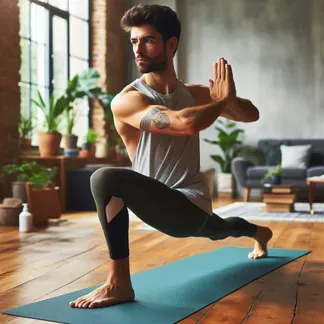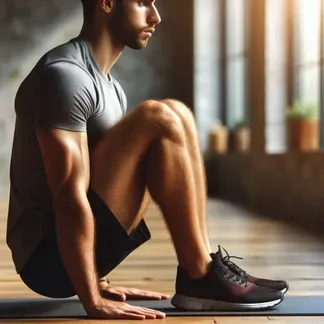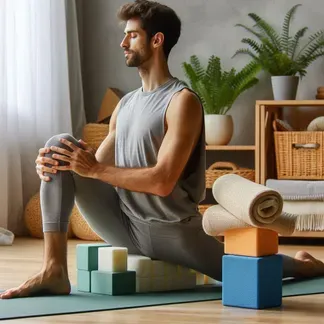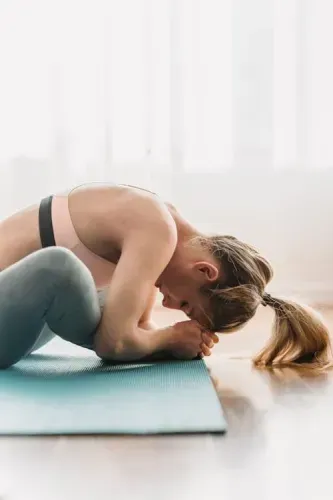Cushioned Knees: How To Prevent Injuries And Improve Performance In Yoga
Table Of Contents
- Importance of Knee Health in Yoga
- Proper Alignment and Posture Techniques
- Strengthening Exercises for Knee Support
- Utilizing Props for Knee Protection
- Mindful Approaches to Avoid Overexertion
- Rest and Recovery Strategies
- Conclusion: Prioritize Knee Care for Sustainable Yoga Practice
Cushioned Knees: Yoga Injury Prevention & Performance Enhancement
Yoga, a practice celebrated for its transformative powers, can sometimes lead to unexpected physical challenges. Cushioned knees play a pivotal role in both preventing injuries and enhancing performance on the mat. With proper attention to knee health, yogis can cultivate a strong foundation for their practice while safeguarding against potential setbacks.
Many yogis overlook the significance of cushioned knees until discomfort or pain arises during their practice. By incorporating targeted exercises and stretches that promote knee strength and flexibility, practitioners can fortify this crucial joint and improve overall stability.
Embracing mindfulness in each movement can also help align the body properly, reducing strain on the knees and fostering a deeper connection with one's practice.
In addition to injury prevention, maintaining resilient knees can unlock new levels of performance in yoga. A solid foundation allows practitioners to explore advanced poses with confidence and grace, enabling them to delve deeper into their spiritual journey through enhanced physical expression.
By prioritizing knee care as an integral part of their routine, yogis empower themselves to embrace the full benefits of their practice with resilience and vitality.
Importance Of Knee Health In Yoga
Maintaining optimal knee health is crucial for yogis to perform at their best and prevent injuries that may hinder their practice. A strong foundation starts from the ground up, literally, with our knees bearing a significant amount of weight and pressure during various yoga poses.
By focusing on strengthening the muscles around the knees through targeted exercises and mindful alignment in poses, practitioners can prevent unnecessary strain and potential injuries.
Engaging in practices that promote flexibility in the hips and ankles can also alleviate stress on the knees during yoga sessions. Asana sequences designed to improve mobility in these areas not only enhance overall performance but also reduce the risk of overloading the knee joints.
Emphasizing proper alignment, avoiding hyperextension, and using props when necessary are additional strategies to ensure that the knees are protected while practising yoga. Remember, taking care of your knees will not only benefit your current practice but also contribute to long-term joint health and longevity in your yoga journey.
Proper Alignment And Posture Techniques

Proper alignment and posture techniques are fundamental aspects of a safe and effective yoga practice. When we align our bodies correctly, we can avoid unnecessary strain on our muscles and joints, reducing the risk of injuries.
It is essential to pay attention to your body's natural alignment cues, such as engaging the core, lengthening the spine, and keeping the shoulders relaxed.
Incorporating mindfulness into your practice can also enhance your alignment by allowing you to focus on how each movement feels in your body. By regularly checking in with your posture during different poses, you can develop greater body awareness and improve your overall performance over time.
Remember that proper alignment is not just about aesthetics; it's about moving mindfully and respecting your body's limitations while still challenging yourself to grow in your practice.
Strengthening Exercises For Knee Support

Engaging in targeted strengthening exercises can be a game-changer when it comes to supporting your knees during yoga practice. One effective exercise is the wall sit, which helps build strength in the quadriceps and glutes, crucial for knee stability. Another beneficial movement is the step-up exercise, specifically using a low platform to improve strength and control in the lower body.
Finally, incorporating resistance band loops around your thighs while performing lateral leg raises can enhance hip abductor muscles that play a role in knee alignment and support.
By focusing on these strengthening exercises, you not only fortify the muscles surrounding your knees but also improve overall joint stability and mechanics. This proactive approach not only reduces the risk of injury but enhances your performance on the mat as well.
Remember to always listen to your body's cues and gradually increase the intensity to avoid overloading your joints. With consistent practice of these strengthening exercises, you are sure to experience increased knee support, allowing you to fully immerse yourself in the meditative flow of yoga with confidence and ease.
Utilizing Props for Knee Protection

Utilizing props for knee protection in yoga can be a game-changer in enhancing your practice. Foam blocks, blankets, or even a folded towel can provide that extra cushioning and support needed for sensitive knees. By placing these props under your knees during poses like tabletop or low lunges, you reduce the pressure on the joint and focus more on alignment and stability.
Moreover, using props can also help modify certain poses to make them more accessible and comfortable for individuals with knee issues. For example, resting your forearm on a block in a pigeon pose can decrease strain on the front knee while still maintaining proper alignment. This not only prevents injuries but allows you to fully engage with the benefits of each posture without compromising your well-being.
Incorporating props into your yoga practice is not a sign of weakness but rather a smart approach to protect your knees and ensure longevity in your journey. Embrace these supportive tools as allies in your practice, allowing you to move mindfully and stay connected with your body’s needs. By prioritizing knee protection through prop utilization, you pave the way for improved performance and sustainable growth on the mat.
Mindful Approaches to Avoid Overexertion
- One mindful approach to avoid overexertion in yoga is to practice active listening to your body. Rather than pushing through discomfort or pain, take a moment to check in with how your body is feeling during each pose. This self-awareness can help you adjust and modify your practice accordingly, preventing unnecessary strain.
- Another effective strategy is to cultivate a mindset of compassion towards yourself. It's important to remember that yoga is not a competition, and there's no need to compare yourself to others or push beyond your limits just for the sake of it. Embracing self-compassion allows you to honour where you are in your practice and make choices that prioritize your well-being over achieving certain poses or levels of flexibility.
- Regular restorative practices such as gentle stretching, meditation, and relaxation techniques can help balance more intense sessions and prevent burnout. By giving yourself time for recovery and rejuvenation, you allow your body and mind the chance to replenish their energy stores and maintain overall health and vitality in your yoga journey.
Adopting these mindful approaches can help you avoid overexertion and enhance the quality of your yoga practice by fostering a deeper connection between mind, body, and spirit.
Rest and Recovery
Strategies

When it comes to optimizing your performance in yoga and preventing injuries, don't overlook the importance of rest and recovery strategies. Rest is not just for physical fatigue but also essential for mental well-being. Incorporating rest days into your routine helps prevent burnout and allows your body to fully recover and repair after intense sessions.
One effective strategy is to focus on quality sleep. Proper sleep not only aids in muscle recovery but also enhances cognitive function and mood regulation.
Alongside this, active recovery techniques such as gentle stretching, foam rolling, or a relaxing swim can help increase blood flow, reduce muscle tension, and promote flexibility—key factors in injury prevention when practising yoga regularly. Remember, nurturing your body with adequate rest ensures longevity in your practice and overall well-being.
Prioritize Knee Care For Sustainable Yoga Practice
In conclusion, it is imperative to prioritize knee care if you wish to maintain a sustainable yoga practice. Your knees bear the brunt of many yoga poses and transitions, making them vulnerable to injuries if not properly cared for.
By incorporating strengthening exercises, warm-ups, and proper alignment techniques into your practice, you can significantly reduce the risk of knee-related issues.
Remember that taking care of your knees goes beyond just physical exercises; listening to your body and honouring its limitations is equally important. Pushing yourself too hard or ignoring signs of discomfort can lead to long-term damage.
Embrace modifications when needed and always be mindful of your movements during practice. Upholding a proactive approach towards knee care will not only enhance your performance on the mat but also ensure that you can continue enjoying the benefits of yoga for years to come.
People Also Asked
Does yoga strengthen the knees?
- Yes, yoga can strengthen the knees by engaging surrounding muscles and improving overall joint stability through targeted poses and exercises.
What yoga poses should you avoid with arthritis in the knees?
- Avoid deep knee bends, full squats, and poses that put excessive pressure on the knees like Lotus Pose or Hero Pose.
What are the 3 benefits of practicing yoga when you are over 50?
- Increased flexibility, improved balance, and enhanced joint health.
What are the 5 benefits of doing yoga workouts?
- Improved flexibility, increased strength, better posture, enhanced mental clarity and reduced stress levels.
Can yoga reduce arthritis?
- Yoga can help reduce arthritis symptoms by improving flexibility, reducing joint pain, and enhancing overall joint function.
What yoga poses should you not do with bad knees?
- Avoid poses that involve deep knee flexion or put a lot of pressure on the knees, like Pigeon Pose or Garland Pose.
What worsens knee arthritis?
- High-impact activities, excessive weight-bearing exercises, and improper alignment can worsen knee arthritis.
What is the best yoga for knee pain?
- Gentle yoga styles such as Hatha, Iyengar, and Restorative Yoga are best for managing knee pain.
What is the best exercise for an arthritic knee?
- Low-impact exercises like swimming, cycling, and gentle yoga are excellent for arthritic knees.
How can I protect my knees during yoga?
- Use props, focus on proper alignment, avoid deep knee bends, and engage in strengthening exercises for surrounding muscles.





